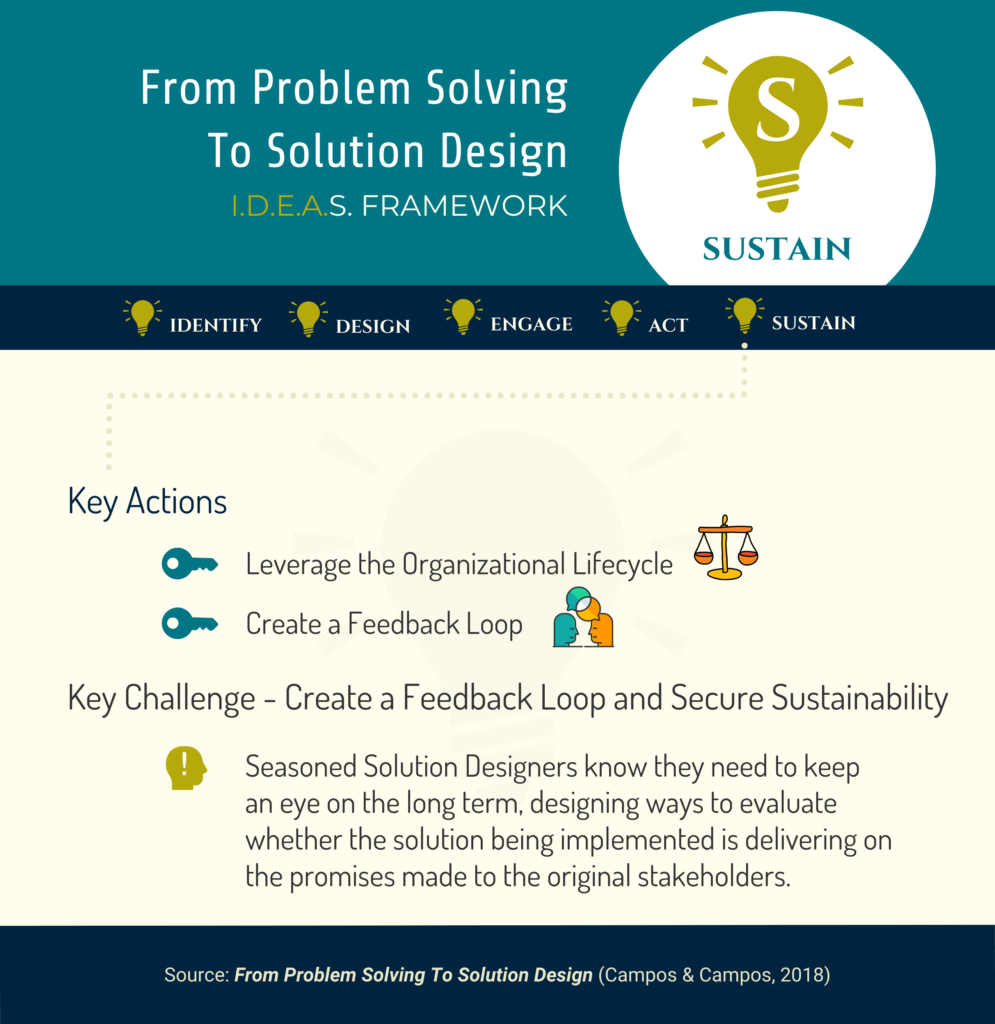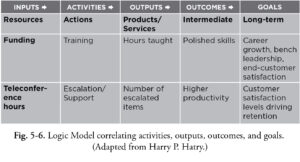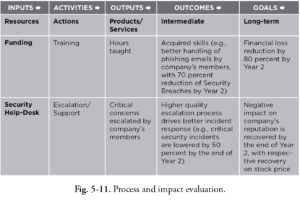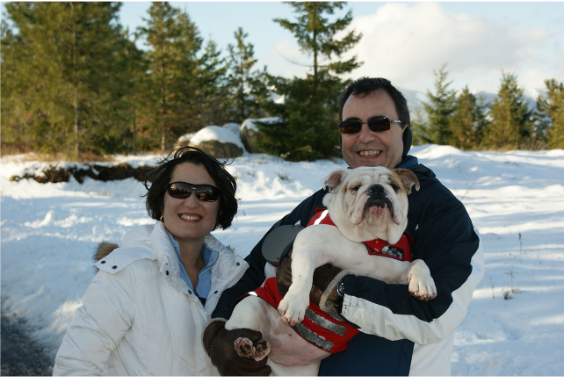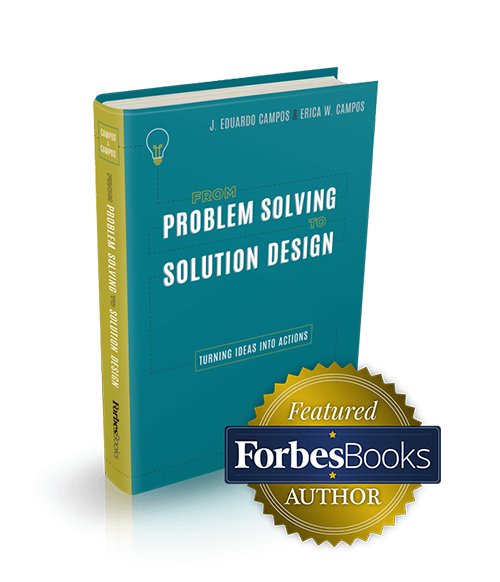In previous blog posts in this series, we’ve discussed the Identify, Design and Engage steps and Act steps from our I.D.E.A.S. Framework, fully detailed in our book From Problem Solving to Solution Design (Campos & Campos, 2018). There are multiple potential challenges in each step of the I.D.E.A.S framework. I’m focusing on just one challenge per article in this series.
After Identifying the problem, Designing a solution by setting goals and assessing options, Engaging stakeholders with a carefully crafted plan, then Acting on our solution implementation, it’s time to stay vigilant and make sure our solution is Sustainable.
Inexperienced Solution Designers often think that their work is done once their plan is being implemented. They may think it’s now up to the stakeholders to work things out. In fact, prioritizing resources as well as stakeholder engagement is more important than ever at this stage of the process.
Throughout the design of your solution, you burned lots of energy convincing stakeholders, negotiating with hesitant parties, and reprioritizing scarce resources to ensure that your solution was successfully implemented. Moreover, the implementation phase may take months to conclude, even years, especially for large organizations with a global presence. To address this “solution-implementation fatigue,” you must acknowledge that the business environment may also change. In truth, after a while, people tend to forget the initial compelling reasons for your solution to be implemented, stakeholders’ enthusiasm recedes, and resources, including people, are redirected to newer, more-pressing issues due to organizational changes or brand-new complex problems that have arisen. Thus, for your solution to stick, you must remain attentive and keep those affected (including yourself) committed through to the end of the implementation phase.
Even when the conclusion of a given solution-implementation project is near, you still must assess what the next steps should be following the project wrap-up. This can contribute to the solution- implementation fatigue mentioned above—organizations have a lifecycle, changing dynamics along the way, and impacting the problems to which the solutions were initially designed.
Key challenges in the SUSTAIN step include:
- Bridging over the moving sands of the organizational lifecycle.
TIP: Evolve or die. - Getting through the transition zones.
TIP: William Bridges’ book Managing Transitions: Making the Most of Change explains the difference between changes and transitions. - Recovering from failure and learning how to succeed from it.
TIP: Do some soul searching to rescue the original purpose. - Create a feedback loop and secure sustainability.
TIP: Communicate your solution results in a way that your audience can understand and give actionable feedback.
We will focus on Challenge #4: Create a feedback loop and secure sustainability.
William Bridges, an author and consultant, has created a model to illustrate how organizations change over time. His model of the organizational lifecycle is helpful in preparing the organization’s leadership to address the inherent issues of each phase of the lifecycle, dealing with the present while keeping an eye on the future. This is important for solution designers to understand because when changes occur in your organization, the validity of your solution might be questioned. Stakeholders may have changed, the organization might have faced a merge or significant modification in its structure and mission, and resources initially available may have been trimmed out to reflect the altered environment.
In extreme cases, the initial solution you designed might not make sense anymore, sometimes because the initial problem has morphed into something else or simply does not exist anymore. Additionally, you have learned about solution failure and recovery, with a special focus on people. All of these items are critical for solution sustainability over time.
Changes might be happening, sometimes slowly, other times concealed beneath the calm waters. How can you ensure that you will spot the signs of change and potential instability? One recommendation is to keep an eye on the intermediate results of your solution (outcomes), while measuring the short-term results (outputs) of it. To increase your solution’s sustainability, you must carry out a regular evaluation of its impact (long-term goals). Because of the nature of the solution implementation phase, when Program Managers are focused on ensuring tasks are executed and results are delivered, Solution Designers might stick to only measuring outputs, and in some cases outcomes, but rarely measure the attainment of the original goals for the solution being implemented.
Seasoned Solution Designers know they need to keep an eye on the long term, designing ways to evaluate whether the solution being implemented is delivering on the promises made to the original stakeholders.
Here are some terms defined and an illustration of the Logic Model, which helps correlate each of these components.
Inputs
- Resources applied in the project to generate deliverables through tasks that are carried out
Activities
- Actions taken within the project used to implement the solution and measured routinely by the project team
Outputs
- Products or services delivered—short-term results, measured by assessing whether the project is providing the products/services it is expected to provide
Outcomes
- Changes in knowledge, skills, and behaviors driven by the implemented solution—intermediate results which are compounded to accrue to the solution’s long-term goals
Goals
- Long-term impact on the organization’s mission, accruing up to its vision—transformative changes in attitudes, skills, and behaviors
As a result of this short-term monitoring and long-term evaluation, you should be able to spot early signs of significant deviations to the original goals for your solution.
Here is a case study demonstrating a real-world scenario on how to create this feedback loop.
Ray Jones, Chief Security Office (CSO) and Vice President of Corporate Security at NichePackages, Inc. was celebrating. A year earlier he was hired to develop an End-User Security Awareness Program by the company’s CEO to reduce the number of security breach incidents. He’d just received the first annual report with results of his flagship program and most metrics showed a positive trend in his departmental scorecard, proving that his team was on the right track to deliver on their commitments to the company.
The Problem: Just before he was due to share these positive results to his CEO and Senior Leadership Team, he was informed that the meeting was postponed to the end of the week because the CEO, Ray’s sponsor in this project, had resigned the night before.
The Issue: Ray made his presentation at the end of the week to his team and the board of directors, who were reviewing all programs directly sponsored by the CEO’s office. After the opening of his presentation, sharing the positive scorecard in the annual report, rapid-fire questioning began, initiated by the Senior Team Members. After a series of incisive questions that Ray could not answer, the COO, acting as interim CEO, stopped the presentation and announced that Ray would return after 4 weeks with all the answers to their questions in hand.
Ray realized quickly that he needed help so he consulted a colleague, CIO Alix Hope. They scheduled a meeting the next day. After hearing about Ray’s presentation and his meeting experience, Alix smiled and said “It’s about separating monitoring and evaluation.” She went on to explain how she breaks down any program or initiative that is longer than 2 quarters. She shared tables, graphics and slides correlating short and long-term goals for any implemented solution.
Ray learned from Alix that Monitoring has an internal focus, targeted at improving the delivery of the outputs. These are short-term metrics. Evaluation, on the other hand, is externally focused, aimed at proving that the results earlier delivered (outputs) will drive real impacts in the long term. Alix also introduced the Logic Model to Ray.
Ray could see clearly that he’d only been measuring short-term activities and he now understood the questions his incomplete presentation generated. He hadn’t made any connection to the program’s long-term goals. Ray used his 4 weeks of preparation time before the follow-up presentation to apply the Logic Model and revise his scorecard.
His presentation was a success and his efforts were appreciated. This motivated Ray to take additional steps. He decided to start the Solution-Design cycle all over again. He created a feedback loop using the new monitoring and evaluation approach to revisit the originally identified essential problem for which the solution was designed to solve, checking his initial envisioned options, updating his Stakeholder Engagement Map, and revising his implemented solution’s goals in light of the new company’s reality. He now understood this is the best way to renew stakeholder support, rally leadership behind his recommendations, and sustain the solution’s effectiveness.
In our final article in this series we will provide a review and offer next steps.
Key Tips for the SUSTAIN Step:
- Acknowledge the organizational lifecycle and leverage it to go through changes.
- Focus on people to successfully get across the transition zones.
- Learn from failure to improve your Solution-Design Process.
- Create a feedback loop and insure sustainability.
Click here to read the Introduction to this series.
Click here to read the post, Identify the problem.
Click here to read the post Design a solution.
Click here to read the post, Engage your stakeholders
Click here to read last week’s post, Act on your solution implementation
Resources:
- Click here for more on From Problem Solving to Solution Design
- Click here for a free chapter from the book.
- Are you offering solutions that matter? Click here for a free Solution Design assessment
- Click here for additional articles, interviews and podcasts
- Click here o learn more about the COSO framework
